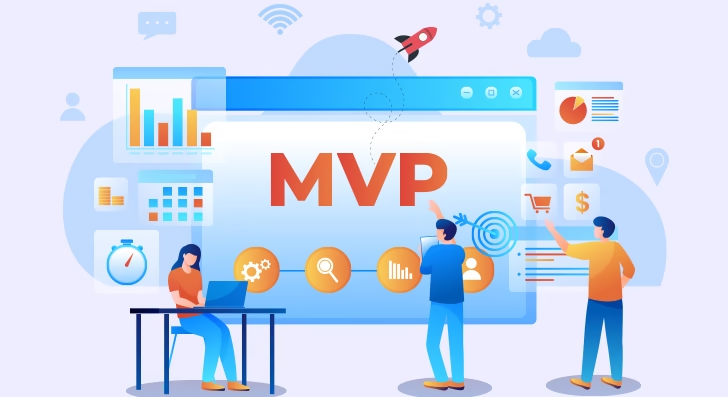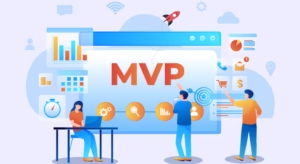Instead of focussing on making the most visually appealing product, success in the high-stakes world of startups is often determined by who can provide the best product in the shortest period of time with the best user input. In addition to being useful, the Minimum Viable Product (MVP) concept is now necessary.
In the startup industry, an MVP is more than just a slogan, it’s a strategic instrument that helps founders to test their product concept, reduce risk, and foster expansion. What is an MVP, though, and why is it the best choice for startups?
Let’s examine it more closely.
Understanding of Minimum Viable Product (MVP)
Firstly learn about what MVP is all about. A minimum viable product is a condensed form of a new product that only has the essential functionality required to address a particular issue for early adopters. Building intelligently is more important than taking shortcuts.
With the MVP method, startups can:
- Start up fast.
- Check your presumptions.
- Gather user opinions
- Iterate using actual data.
The secret is to have just enough functionality to be useful and usable while still allowing for development and learning. An MVP offers a clear route to determining user preferences rather than speculating about them.
The Foundation of Startup Success
Any startup hoping to succeed in the long run has to understand the concept of a Minimum Viable Product (MVP). An MVP is the foundation for future company expansion. Startups can accelerate their product’s market debut and begin collecting feedback without straining their funds or resources by carefully choosing key features. By grasping this idea, founders may concentrate their efforts on what their audience finds most important.
This blog’s main goal is to provide startup founders with the information they need to benefit from MVP practices. We will examine several aspects of MVP benefits in the given sections, such as how to increase cost effectiveness, and validate company concepts, providing a comprehensive perspective on success-oriented tactics.
Why MVPs Win for Startups
1. Validate Your Idea Without Wasting Resources
Startups have a limited budget, time, and workforce. It can be expensive to develop a full-scale product before putting it to the test in the marketplace. Before investing much, you can test your idea with real people by establishing an MVP development service.
For example: Dropbox began by showcasing the product’s functionality through a brief video demonstration. They were able to confirm demand before building a single line of code thanks to that video alone.
2. Faster Time to Market
In the startup environment, speed is a competitive advantage. You may launch more quickly, begin gathering data, and maintain an advantage over possible rivals with the aid of an MVP.
You could launch in a few months (or even weeks) and test your hypotheses before anyone else does, saving a year of development time.
3. User-Centered Product Development
Creating an MVP promotes lifelong learning. You’re listening, not guessing what users want. You can decide which features should be dropped and which should be built next by getting input early.
The likelihood of creating a product that people genuinely need is increased and the danger of product failure is decreased with this type of customer-led development.
4. Set aside money for expansion and iteration
Let’s face it, startups rarely enjoy the luxury of endless cash. Instead than investing all of your money in a feature-rich product that might not sell, you should focus on user behavior-based iteration, market research, and client acquisition.
By concentrating on a core set of features, post-launch exploration and improvement are made possible.
5. Attract Investors with Real Metrics
An MVP offers both a working prototype and proof of concept. When you’re seeking to raise money, you may convince investors with real usage data, customer feedback, and product iterations much more effectively than with simply an idea.
Startups with MVPs are often distinguished by their proven ability to execute, learn, and adjust quickly.

Features of a Successful MVP
Cutting features carelessly is not the goal of creating an MVP. It’s a planned procedure that calls for preparation and clarity. Every startup MVP should have the following:
- Clearly Stated Problem
You must be aware of the problem you are attempting to resolve. An MVP won’t be successful no matter how well-designed it is if it doesn’t address a key need for users.
- Identified Target Market
Your MVP is for your early adopters, not everyone else. These consumers are more likely to offer candid comments and try out novel solutions.
- Crucial Elements Only
Pay attention to characteristics that have a direct bearing on resolving the main issue. Avoid the temptation to overbuild. Generally speaking, don’t include a feature if it doesn’t support your main theory.
- Manner of Feedback
Facilitate user feedback sharing. The secret to MVP success is gathering and evaluating feedback, whether via surveys, user interviews, or in-app analytics.
- Plan of Iteration
You will require an iteration plan after your MVP goes live. Which metrics are you going to monitor? How frequently will you go over the comments? How do you decide whether to include additional features?
From Idea to MVP in 8 Steps
Step 1: Describe the issue
To determine what people are seeking for and how your business concept may help them with their pain point, you must conduct extensive research. The platform will be able to obtain the true insights and extent of a business idea as a result.
Step 2: The intended audience
Businesses may develop an accurate marketing strategy and user-centric solutions by being clear and specific about the target group they wish to pitch to. The MVP development company will be able to provide the product more effectively after the organisation has a clear understanding of its goals and target market.
Step 3: Employ Developers of MVPs
The best and most economical course of action would be to hire a full stack software development company to create the platform. Employ a company that can assist you at every stage of the process, from full-cycle software development to MVP development and business consulting.
Step 4: Arrange your trip
Once you have found a trustworthy and knowledgeable MVP development company, they can handle the rest. The business will receive assistance from the contracted business experts in creating the platform’s blueprint for flawless delivery. Establishing an in-house team is far more expensive than hiring an outsourced organisation.
Step 5: Essential Elements
Talk with the hired team and incorporate the key features that directly address and resolve user enquiries into the product. In the initial phase of MVP development, make sure not to overlook any of the platform’s most fundamental and important elements.
Step 6: Proper Tech Stack
One of the things that startups shouldn’t skimp on is acquiring the right and trustworthy tech stack for product development. To create a user-friendly platform, talk about and acquire the most secure and user-focused tech stack.
Step 7: Start a Small Test
Introduce the MVP product to the online market to get opinions, comments, and criticism. This test will assist the firm in revising, improving, and making the platform more dependable, easy to use, and growth-oriented.
Step 8: Expand
Consult with the MVP development company and make necessary platform enhancements to maximise the potential of the business idea based on user feedback and responses.
MVP Isn’t Just a Product, It’s a Mindset
The MVP approach emphasises agility, learning, and speed. Building an MVP is a risk-reduction tactic that enables you to go swiftly without throwing caution to the wind in a world where 90%of startups fail.
Launching the correct product that addresses actual issues and changes in response to feedback from the real world is more important than launching a flawless one.
Consider this your cue if you’re a startup in the idea stage: start creating your MVP instead of waiting to be flawless. It may turn out to be your best decision ever.














